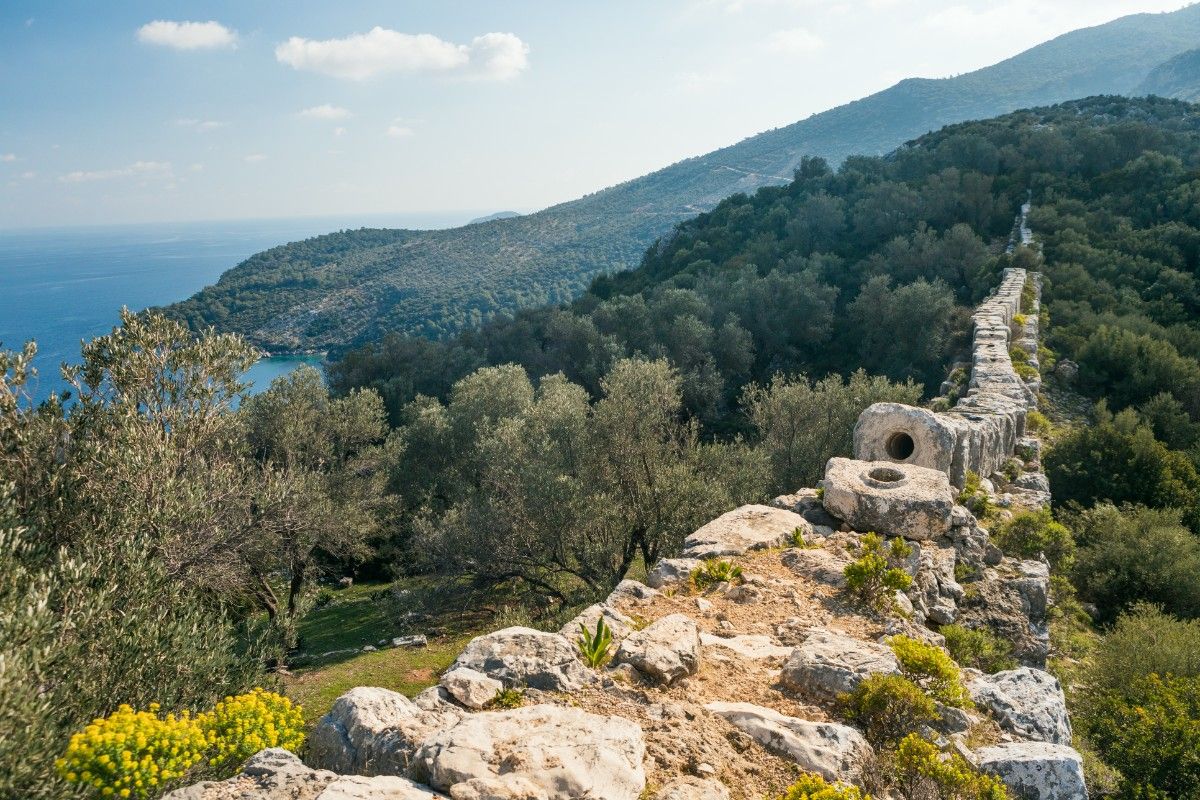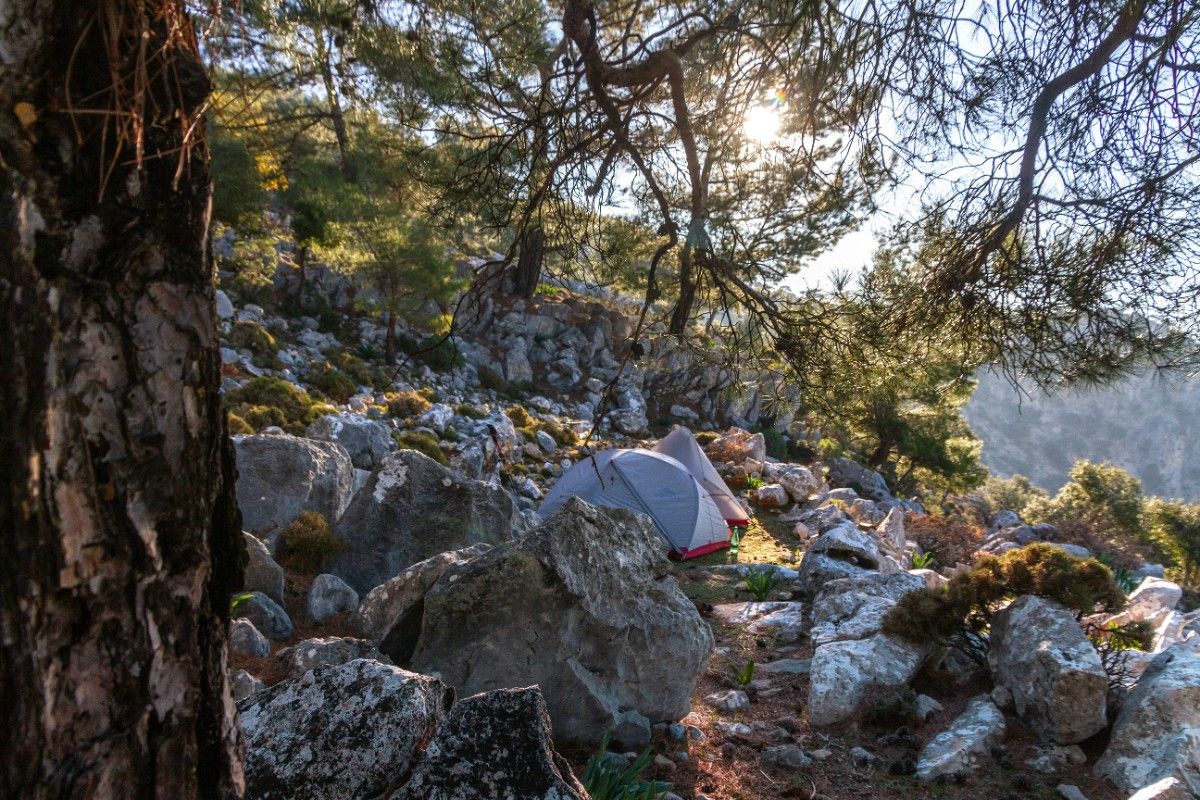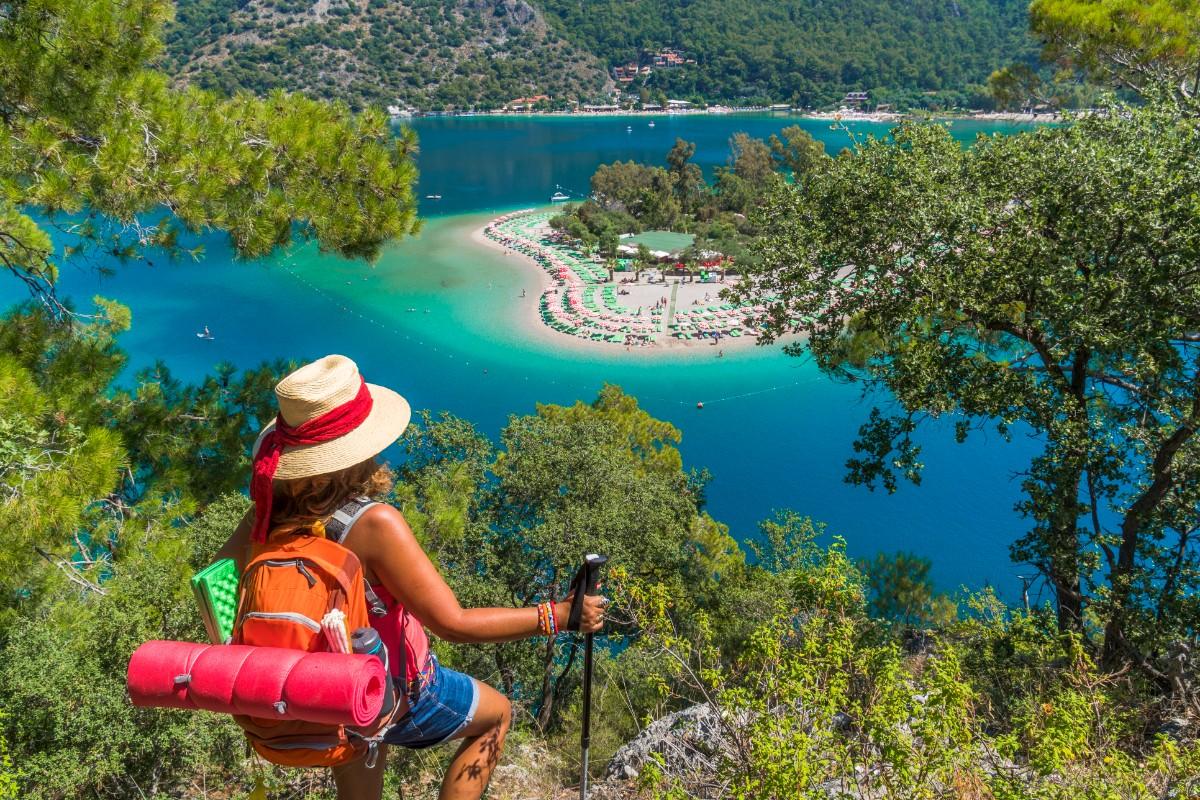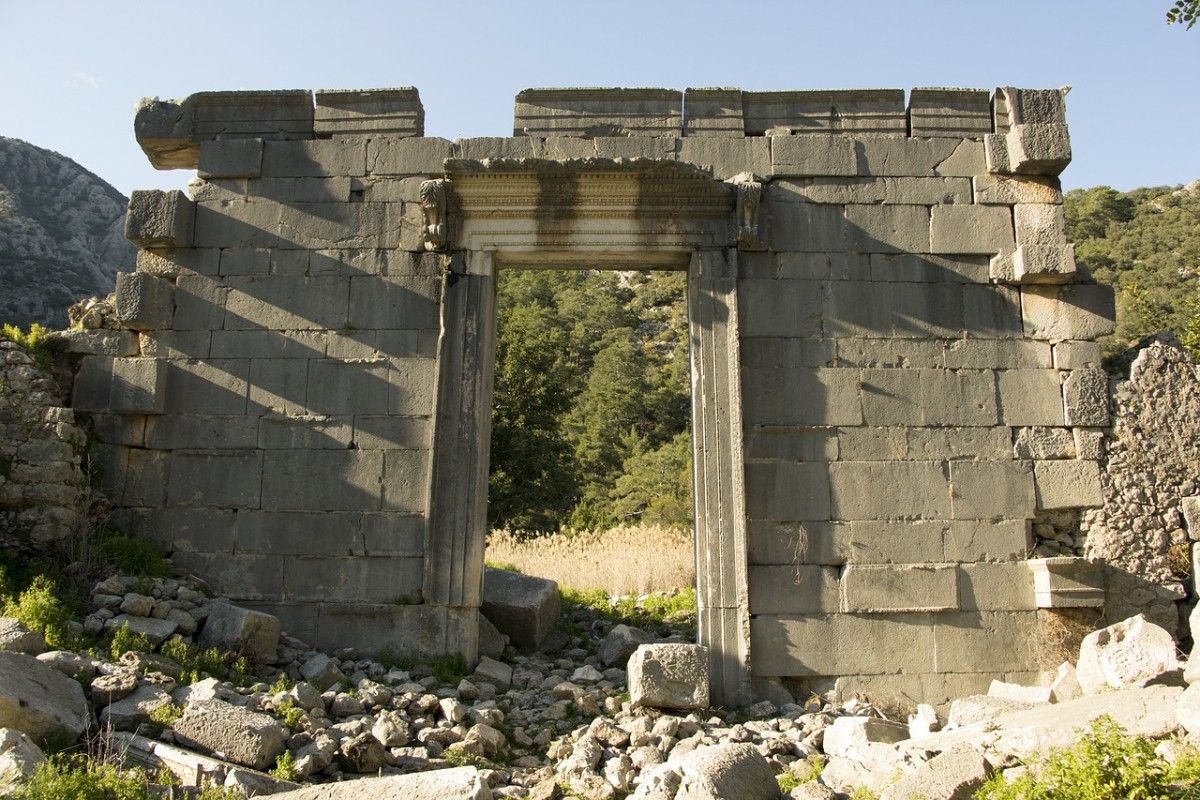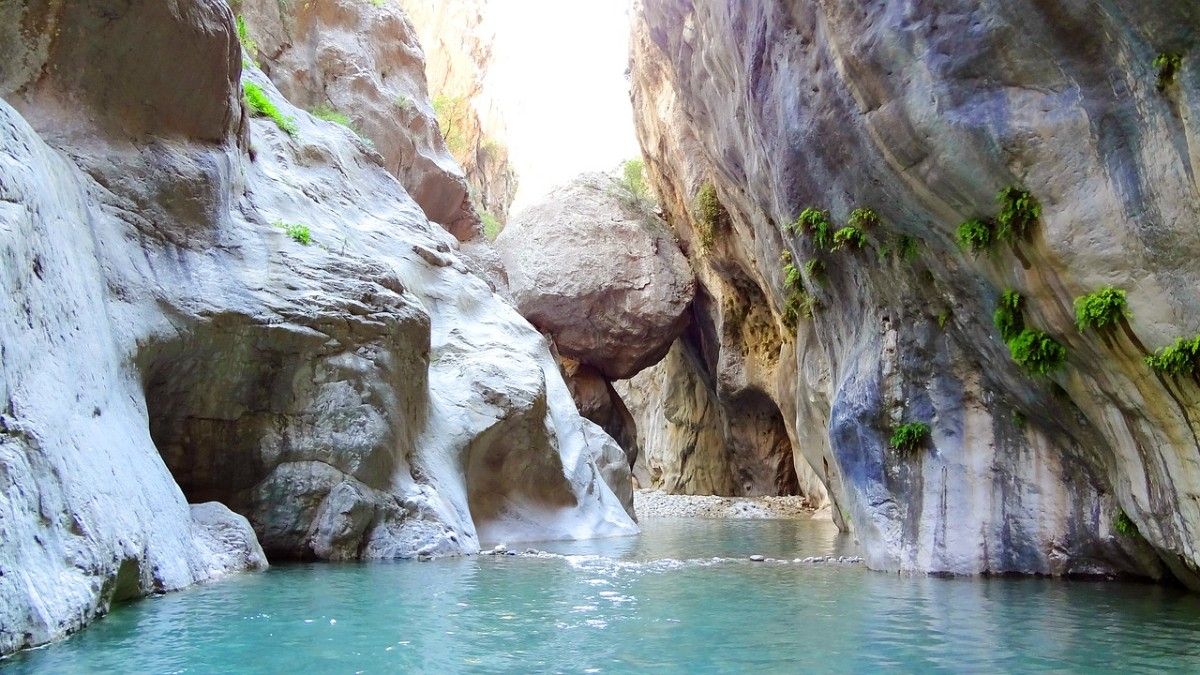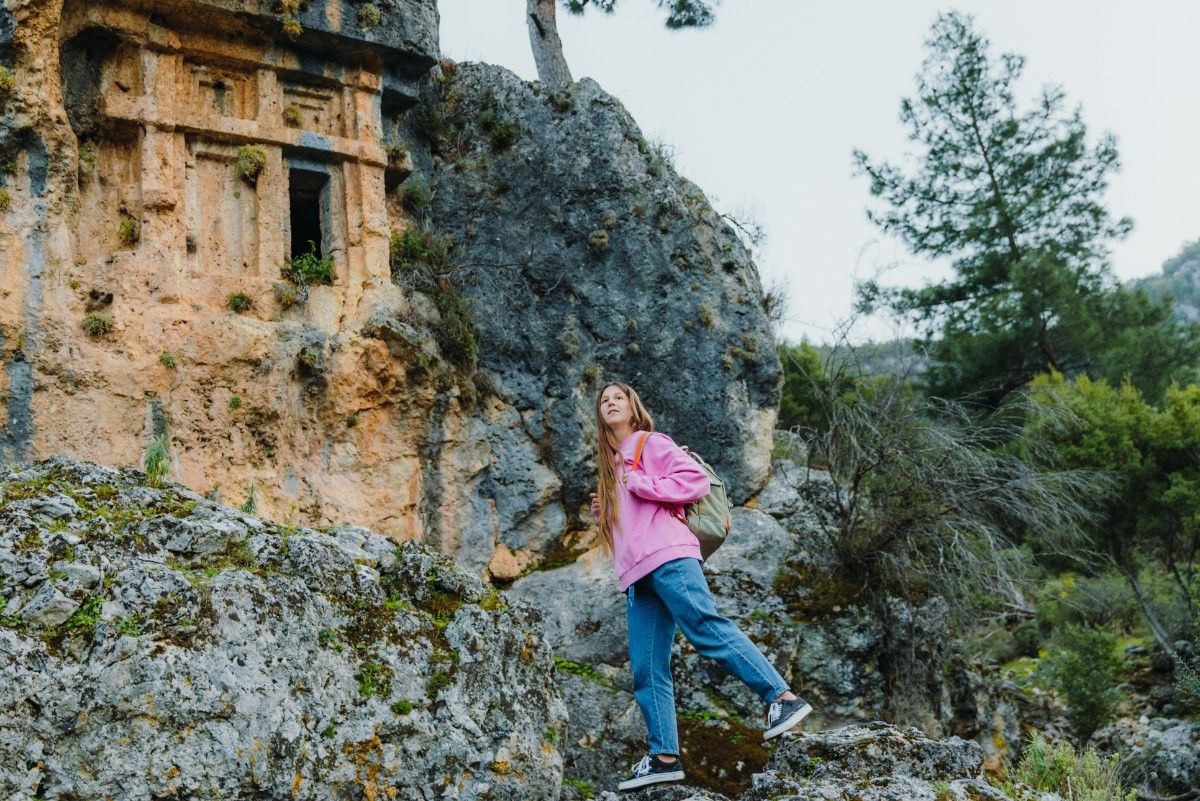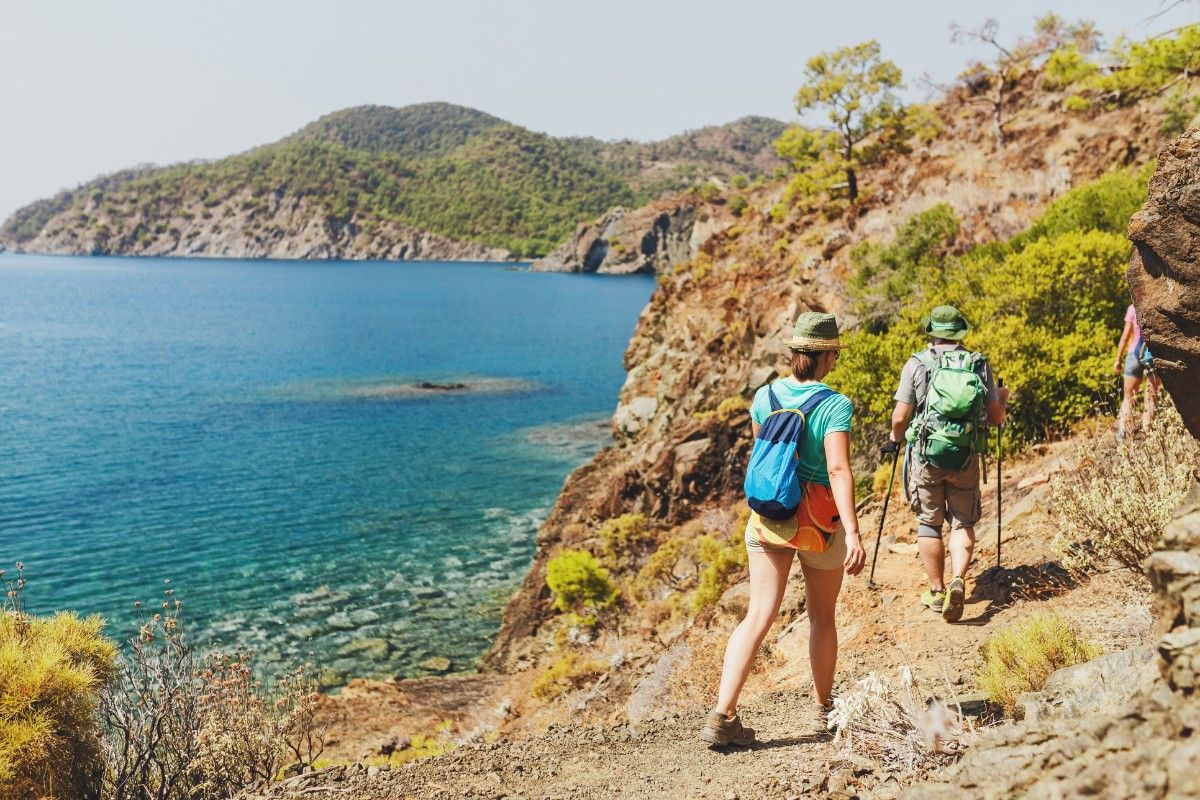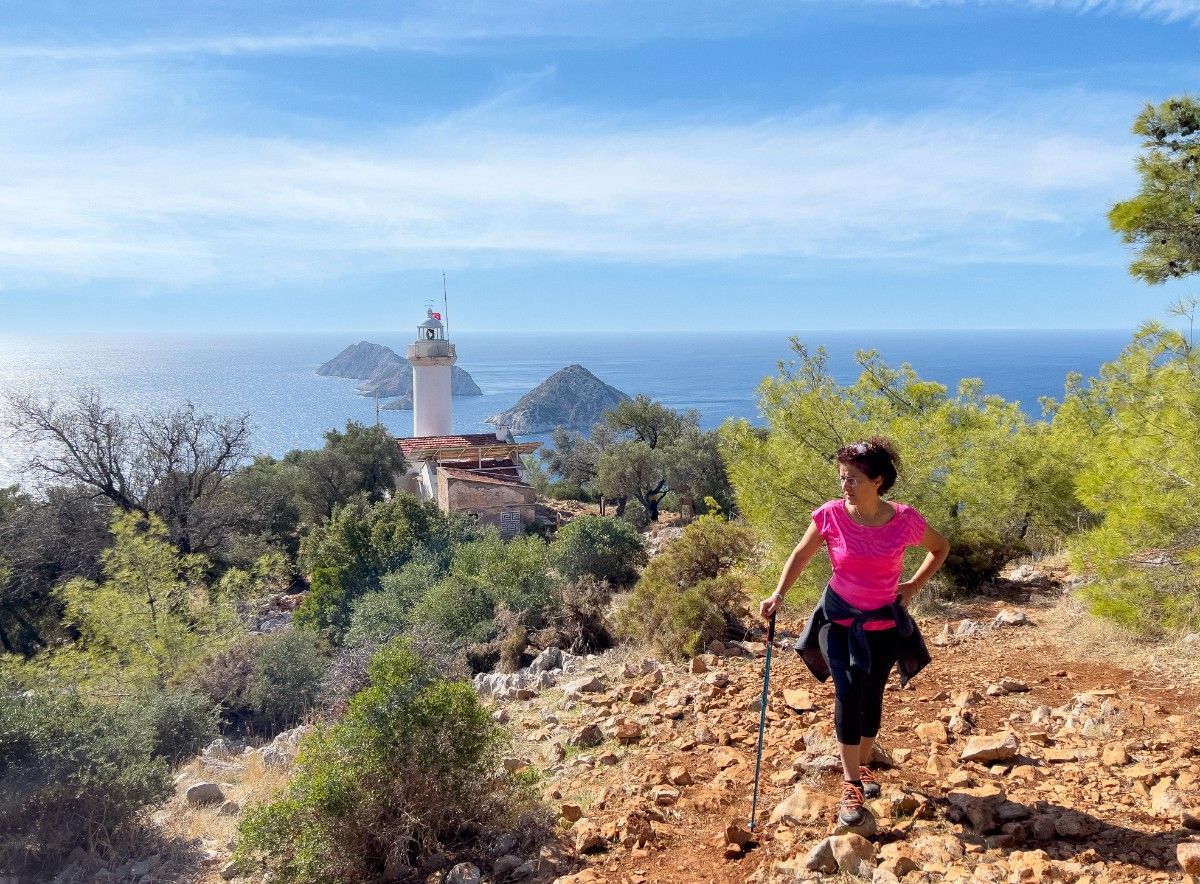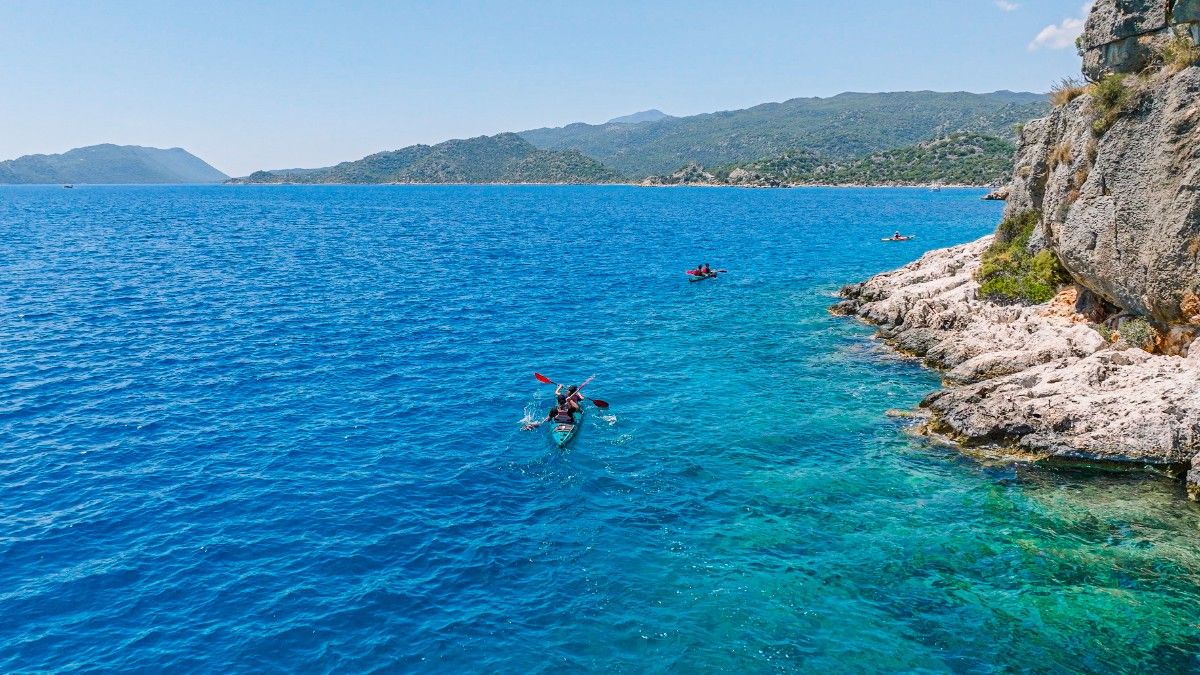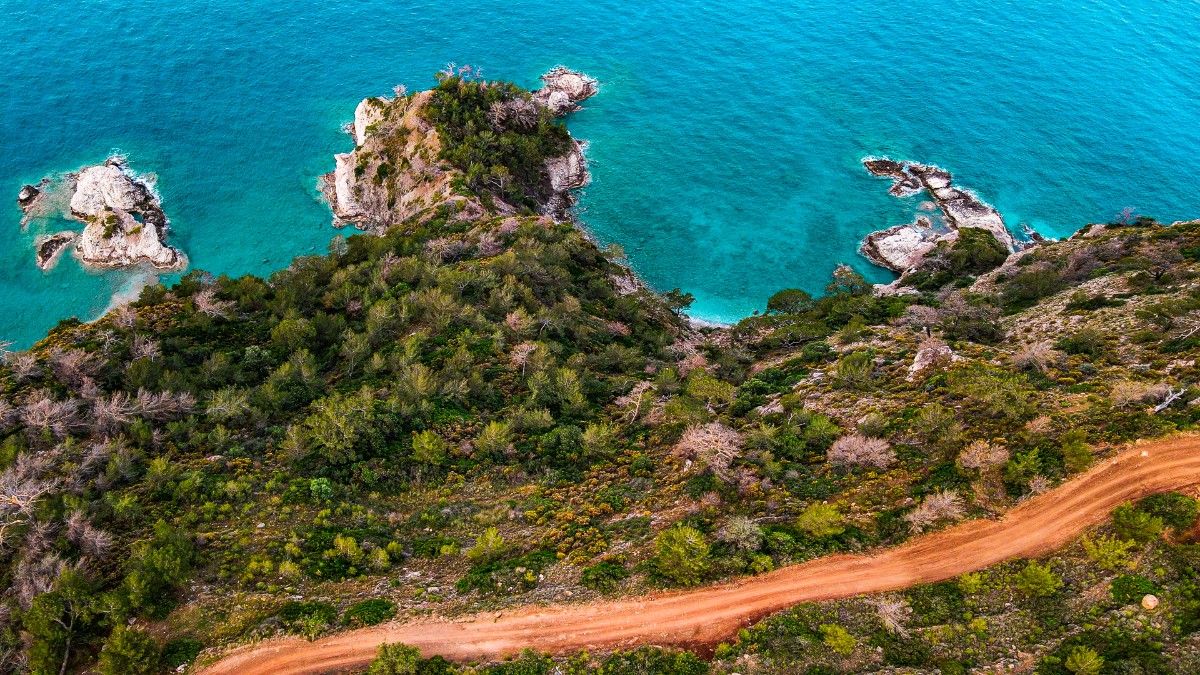Discovering the Lycian Way
The Allure of the Lycian Way
The Lycian Way is a captivating long-distance hiking trail that winds along the stunning Mediterranean coastline of Turkey. This 540-kilometre trail stretches from Fethiye to Antalya, offering hikers an unparalleled opportunity to immerse themselves in the region's natural beauty, rich history, and warm local culture. The Lycian Way in Turkey has gained international recognition for its well-marked paths, diverse landscapes, and the hospitality of the communities along the route. Whether you're an experienced hiker seeking a new challenge or a curious traveller looking for an authentic adventure, the Lycian Way promises an unforgettable journey through the heart of Turkey's breathtaking Turquoise Coast.
The trail takes its name from the ancient Lycian civilisation that once thrived in the region during the first millennium BCE. As you trek along the Lycian Way, you'll encounter numerous remnants of this fascinating civilisation, including rock-cut tombs, ancient cities, and sections of Roman roads. The route itself was established in 1999 by the British expat Kate Clow, who painstakingly mapped and marked the trail, making it accessible to hikers from all over the world. Since its creation, the Lycian Way has become a beloved destination for those seeking a unique and immersive hiking experience in Turkey.
History and Mythology
The Lycian Way is steeped in history and mythology, adding a fascinating layer of depth to your hiking experience. As you traverse the trail, you'll find yourself walking in the footsteps of ancient civilisations and legendary figures. According to Greek mythology, the Lycian coast was home to the Chimera, a monstrous creature with the head of a lion, the body of a goat, and the tail of a serpent. The myth of the Chimera is tied to the eternal flames of Yanartaş, a natural phenomenon caused by methane gas seeping through the rocks near the ancient city of Olympos.
The region was also a significant centre of early Christianity, with several important figures, such as Saint Nicholas, hailing from the area. Saint Nicholas, who served as the bishop of Myra in the 4th century, is believed to be the inspiration behind the modern-day figure of Santa Claus. As you hike along the Lycian Way, you'll have the opportunity to visit the Church of Saint Nicholas in Demre, where the saint's tomb once stood.
Throughout history, the Lycian coast has been influenced by various civilisations, including the Persians, Greeks, Romans, and Byzantines. Each of these cultures left their mark on the region, as evidenced by the numerous archaeological sites scattered along the Lycian Way. From the impressive rock-cut tombs of Myra to the well-preserved Roman theatre at Patara, the trail offers a fascinating glimpse into the region's rich and diverse past.
Exploring the Diverse Landscapes
Coastal Delights
One of the most striking features of the Lycian Way is its stunning coastal scenery. As you hike along the trail, you'll be treated to breathtaking views of the turquoise waters of the Mediterranean Sea, pristine beaches, and secluded coves. The route hugs the coastline for much of its length, offering numerous opportunities to take a refreshing dip in the crystal-clear waters or simply relax on the shore and soak up the sun.
One of the most iconic sections of the Lycian Way is the stretch between Ölüdeniz and Faralya, which includes the famous Butterfly Valley. This enchanting cove, accessible only by boat or a steep hike down from the trail, is a true paradise. The valley derives its name from the numerous species of butterflies that call it home, and it features a magnificent waterfall cascading down from the cliffs above. Taking a dip in the cool, clear waters of Butterfly Valley is an experience not to be missed.
As you continue along the trail, you'll encounter numerous other coastal gems, such as Kabak Beach, Patara Beach, and Adrasan Beach. Each of these stunning locations offers its own unique character and charm, from the tranquil seclusion of Kabak to the expansive golden sands of Patara, which is known as one of the longest beaches in the Mediterranean.
Inland Adventures
While the coastal sections of the Lycian Way are undeniably stunning, the trail also offers a wealth of inland treasures waiting to be discovered. As you venture away from the sea, you'll find yourself immersed in fragrant pine forests, olive groves, and scenic mountain landscapes. The trail reaches its highest point at Mount Tahtalı, also known as Olympos, which stands at an impressive 2,366 metres above sea level. The ascent to the summit is challenging but immensely rewarding, offering panoramic views of the surrounding landscape and the distant sea.
One of the most picturesque inland sections of the Lycian Way is the Göynük Canyon, a dramatic gorge carved by the Göynük River. The trail winds through the canyon, offering hikers a chance to marvel at the towering cliffs, waterfalls, and lush vegetation. The cool, shaded environment of the canyon provides a welcome respite from the heat of the sun, making it an ideal spot for a picnic or a refreshing swim in the river.
As you explore the inland regions of the Lycian Way, you'll also have the opportunity to visit charming mountain villages and experience the traditional way of life of the local communities. These villages often serve as perfect rest stops for hikers, offering comfortable accommodations, delicious Turkish cuisine, and a chance to interact with friendly locals. Immersing yourself in the rural culture and hospitality of these villages is an integral part of the Lycian Way experience, allowing you to gain a deeper appreciation for the region's unique character and traditions.
Uncovering Ancient History
Lycian Rock Tombs and Sarcophagi
As you hike along the Lycian Way, you'll encounter numerous reminders of the region's rich ancient history. One of the most striking features of Lycian culture is the elaborate rock-cut tombs and sarcophagi that dot the landscape. These intricately carved structures, often resembling houses or temples, were created to honour the dead and provide them with a comfortable afterlife.
Some of the most impressive examples of Lycian rock tombs can be found in the ancient city of Myra, near the modern town of Demre. The tombs, dating back to the 4th century BCE, are carved into the sheer cliffs overlooking the city. The facades of these tombs are adorned with intricate reliefs and inscriptions, offering a glimpse into the beliefs and artistic traditions of the Lycian people.
Another notable site for Lycian rock tombs is the ancient city of Tlos, located near the town of Seydikemer. Here, you'll find a cluster of tombs cut into the rocky hillside, including the impressive Tomb of Bellerophon, named after the legendary Greek hero who is said to have slain the Chimera. As you explore these ancient sites along the Lycian Way, you'll gain a deeper appreciation for the skill and artistry of the Lycian craftsmen who created these enduring monuments.
Ancient Cities and Ruins
The Lycian Way passes through several ancient cities and ruins that offer a fascinating glimpse into the region's long and complex history. One of the most significant sites along the trail is the ancient city of Olympos, located near the modern village of Çıralı. Olympos was once a thriving Lycian city, later occupied by the Romans, and today, hikers can explore the extensive ruins, including the remains of temples, bathhouses, and a well-preserved theatre.
Another notable ancient city along the Lycian Way is Phaselis, situated on a picturesque peninsula between the towns of Olympos and Tekirova. Phaselis was an important trading port in ancient times, and its ruins showcase a mix of Lycian, Greek, and Roman influences. As you wander through the ancient streets, you'll encounter the remains of aqueducts, agoras, and a stunning Roman theatre overlooking the Mediterranean Sea.
The Lycian Way also passes through the UNESCO World Heritage Site of Xanthos, which served as the capital of ancient Lycia. Here, you'll find an impressive acropolis, a well-preserved theatre, and the remains of several ornate tombs, including the famous Harpy Monument. Exploring these ancient cities and ruins along the trail offers a tangible connection to the region's storied past and provides a unique opportunity to imagine life in these once-thriving communities.
Experiencing Local Culture and Hospitality
Traditional Turkish Villages
One of the most rewarding aspects of hiking the Lycian Way is the opportunity to immerse yourself in the local culture and experience the warm hospitality of the Turkish people. As you walk through the picturesque villages that dot the trail, you'll have the chance to interact with friendly locals, sample traditional cuisine, and gain insight into the region's unique way of life.
Many of these villages have remained relatively untouched by mass tourism, preserving their authentic character and charm. As you stroll through the narrow, cobblestone streets, you'll be greeted by the sight of whitewashed houses adorned with colourful bougainvillea, old men playing backgammon in quaint cafes, and women crafting traditional textiles.
One such village is Bezirgan, nestled in the foothills of the Taurus Mountains. This charming settlement is known for its traditional stone houses, terraced gardens, and the warm hospitality of its residents. Many hikers choose to spend a night in Bezirgan, staying in a cosy guesthouse and enjoying a home-cooked meal prepared with fresh, local ingredients. Engaging with the locals in villages like Bezirgan offers a unique opportunity to learn about their customs, traditions, and daily life, enriching your understanding of the region's vibrant culture.
Delicious Turkish Cuisine
No exploration of local culture along the Lycian Way would be complete without indulging in the mouthwatering delights of Turkish cuisine. As you hike through the villages and towns, you'll have ample opportunities to sample an array of traditional dishes that showcase the region's rich culinary heritage.
One of the most iconic dishes you'll encounter is gözleme, a savoury Turkish flatbread filled with various ingredients such as spinach, cheese, or minced meat. These delectable treats are often prepared by local women who expertly roll out the dough and cook the gözleme over a large griddle, creating a crispy and satisfying snack that's perfect for refuelling during your hike.
Another staple of Turkish cuisine that you'll find along the Lycian Way is the famous Turkish kebab. From the succulent şiş kebab (skewered and grilled meat cubes) to the Adana kebab (spicy minced meat kebab), these flavourful dishes are a testament to the country's love for grilled meats and bold flavours. Paired with fresh salads, creamy dips, and warm pide bread, a Turkish kebab meal is a satisfying and memorable culinary experience.
In addition to these savoury delights, be sure to save room for some of Turkey's legendary sweet treats. Baklava, a rich pastry made with layers of phyllo dough, nuts, and syrup, is a must-try dessert that perfectly embodies the country's sweet tooth. You'll also find plenty of opportunities to sip on aromatic Turkish tea or coffee, often served in small, tulip-shaped glasses and accompanied by friendly conversation with locals.
Planning Your Hike
Choosing Your Route and Duration
The first step in planning your Lycian Way hike is deciding on the length and duration of your trek. With a total length of 540 kilometres, the Lycian Way offers a range of options to suit different hiking abilities and time constraints. While some experienced hikers may choose to tackle the entire trail in one go, most opt to focus on shorter sections that highlight specific areas of interest.
When selecting your route, consider your fitness level, the time you have available, and the key attractions you want to experience along the way. Some of the most popular sections of the Lycian Way include the stretch from Fethiye to Ölüdeniz, which offers stunning coastal views and access to the famous Butterfly Valley, and the portion from Kaş to Üçağız, which showcases the ancient ruins of Aperlae and the charming fishing village of Kaleköy.
To help plan your route, consult the Lycian Way map, which provides a detailed overview of the trail and its various sections. The map highlights important landmarks, such as ancient sites, beaches, and villages, as well as the locations of accommodation options and water sources. By studying the Lycian Way Turkey map and reading up on the highlights of each section, you can create an itinerary that aligns with your interests and hiking goals.
Accommodation and Resupply Points
Once you've selected your route, it's crucial to plan your accommodation and resupply points along the Lycian Way. The trail passes through numerous villages and towns that offer a range of lodging options, from basic guesthouses and campsites to more comfortable boutique hotels. Consider your budget, comfort preferences, and the location of these accommodations when planning your overnight stops.
It's recommended to book your accommodation in advance, especially during the peak hiking seasons of spring (April to May) and fall (September to November). This ensures that you have a guaranteed place to rest after a long day on the trail and helps you avoid the disappointment of fully booked lodgings.
In terms of resupply points, most villages along the Lycian Way have small shops or markets where you can purchase basic groceries, snacks, and water. However, it's essential to carry some extra supplies, such as energy bars, trail mix, and a water filtration system, in case of unexpected closures or long stretches between villages. By planning your resupply points in advance, you can ensure that you have sufficient provisions to fuel your hike without carrying an excessive load.
Essential Gear and Packing Tips
To ensure a safe and comfortable Lycian Way trek, it's crucial to pack the right gear and equipment. A sturdy, well-fitted backpack is essential for carrying your supplies and distributing weight evenly. Choose a backpack with a capacity of 40-60 litres, depending on the length of your hike and your packing style.
Invest in a pair of high-quality, comfortable hiking boots that provide good ankle support and traction. Break in your boots before your hike to prevent blisters and ensure a comfortable fit. Bring a mix of lightweight, moisture-wicking clothing that can be layered to adapt to changing weather conditions. Don't forget to pack a waterproof jacket, hat, and sunglasses to protect yourself from the elements.
Other essential items for your Lycian Way packing list include a reliable water filtration system or purification tablets, a first-aid kit, a headtorch or torch, and a sleeping bag or liner if you plan on staying in campsites or basic guesthouses. Consider bringing trekking poles to help maintain balance and reduce strain on your knees, especially during steep ascents or descents.
When packing your backpack, aim to keep your load as light as possible while still ensuring you have all the necessary equipment. A good target weight for your backpack is 10-15% of your body weight. To achieve this, focus on bringing versatile, lightweight items that serve multiple purposes, and consider sharing gear with your hiking partners to distribute weight evenly.
Navigating the Trail
Trail Markings and Waypoints
One of the most appealing aspects of hiking the Lycian Way is the well-established trail marking system that makes navigation relatively straightforward, even for novice hikers. The trail is marked with red and white stripes painted on rocks, trees, and other landmarks along the route. These distinctive markings are typically placed at regular intervals, ensuring that hikers can confidently follow the path and stay on course.
In addition to the red and white stripes, the Lycian Way also features waypoint signs at key junctions or intersections. These signs often display the names of nearby villages, the distance to the next waypoint, and the estimated hiking time. By keeping an eye out for these waypoint signs, you can track your progress along the trail and make informed decisions about rest stops and overnight stays.
While the trail markings are generally reliable, it's essential to remain vigilant and attentive while hiking. In some cases, markings may be faded, obscured, or missing altogether due to weather conditions or lack of maintenance. To avoid getting lost, always carry a detailed Lycian Way trail map and a reliable compass or GPS device as a backup.
Navigational Tools and Techniques
In addition to relying on the trail markings, it's highly recommended to bring a detailed topographical map of the Lycian Way and a dependable navigational tool. A paper map provides a comprehensive overview of the trail, including elevation profiles, distances, and the locations of key landmarks and services. By familiarising yourself with the map before your hike and consulting it regularly during your trek, you can stay informed about the terrain ahead and make strategic decisions about your route.
To complement your paper map, consider using a GPS device or a smartphone with offline mapping capabilities. GPS technology allows you to pinpoint your precise location on the trail and track your progress in real-time. Many hikers use dedicated GPS devices, such as those manufactured by Garmin or Suunto, which offer rugged construction, long battery life, and preloaded Lycian Way GPS tracks.
Alternatively, you can use a smartphone with an offline mapping app, such as Gaia GPS or Maps.me. These apps allow you to download detailed topographical maps of the Lycian Way and access them even without an internet connection. By using your smartphone's GPS capabilities in conjunction with the offline maps, you can navigate the trail with confidence and easily locate your position relative to key landmarks and services.
It's worth noting that while technology can be a valuable navigational aid, it's essential not to rely on it exclusively. Batteries can die, devices can malfunction, and signal reception can be unreliable in remote areas. Always carry a backup navigational tool, such as a compass or a printed map, and familiarise yourself with basic navigational techniques, such as reading terrain features and orienting yourself using the sun or stars.
Lycian Way Weather and Best Time to Hike
Seasonal Weather Patterns
The Lycian Way experiences a typical Mediterranean climate, characterised by hot, dry summers and mild, wet winters. Understanding the seasonal weather patterns is crucial for planning your hike and ensuring a safe and enjoyable experience on the trail.
Spring (March to May) is considered one of the best times to hike the Lycian Way. During this season, temperatures are mild, with average daytime highs ranging from 20°C to 25°C. The landscape is lush and vibrant, with wildflowers blooming along the trail and creating a stunning display of colour. While spring is generally pleasant, it's important to note that there is a higher chance of rainfall compared to the summer months, particularly in March and April. Be prepared for occasional showers and pack appropriate waterproof gear.
Summer (June to August) is the hottest and driest time of year on the Lycian Way. Temperatures can soar above 35°C, making hiking conditions challenging and potentially dangerous. If you choose to hike during the summer, it's crucial to start early in the morning, take frequent breaks in the shade, and carry plenty of water to stay hydrated. The upside of hiking in summer is the minimal chance of rainfall and the long, sunny days that allow for extended hiking hours.
Fall (September to November) is another excellent time to hike the Lycian Way, with comfortable temperatures and lower chances of rainfall compared to spring. The average daytime highs range from 20°C to 30°C, creating ideal conditions for hiking. The landscape takes on a golden hue as the vegetation transitions into autumn colours, offering a unique and picturesque backdrop for your trek.
Winter (December to February) is the coolest and wettest season on the Lycian Way. While temperatures rarely drop below freezing, the average daytime highs range from 10°C to 15°C. Rain is more frequent during this time, and some sections of the trail may become muddy or slippery. If you plan to hike in winter, be prepared for variable weather conditions and pack warm, waterproof clothing. Keep in mind that some accommodations and services along the trail may be closed during the winter months.
Choosing the Best Time for Your Hike
When deciding on the best time to hike the Lycian Way, consider your personal preferences, hiking experience, and tolerance for various weather conditions. If you prefer mild temperatures and don't mind occasional rainfall, spring or fall may be the ideal seasons for you. These seasons offer comfortable hiking conditions, stunning natural beauty, and a more tranquil experience with fewer crowds on the trail.
If you thrive in hot weather and prioritise clear, sunny skies, summer may be your preferred time to hike. However, be aware of the challenges posed by high temperatures and take necessary precautions to avoid heat exhaustion and dehydration.
For those who enjoy a quieter hiking experience and don't mind cooler temperatures, winter can be a suitable time to explore the Lycian Way. While the weather may be more unpredictable, you'll have the trail largely to yourself and can experience a different side of the region's beauty.
Ultimately, the best time to hike the Lycian Way depends on your individual preferences and hiking goals. By understanding the seasonal weather patterns and considering your own comfort level, you can choose the time that aligns with your ideal hiking experience.
Immersing Yourself in the Magic of the Lycian Way
Embracing the Journey
Hiking the Lycian Way is more than just a physical challenge; it's an opportunity to immerse yourself in the region's stunning natural beauty, rich history, and warm local culture. To fully embrace the magic of this iconic trail, approach your journey with an open mind and a willingness to step outside your comfort zone.
As you traverse the diverse landscapes of the Lycian Way, take the time to appreciate the breathtaking vistas that unfold before you. Marvel at the turquoise waters of the Mediterranean Sea, the rugged coastline dotted with hidden coves and pristine beaches, and the lush forests that blanket the mountains. Allow yourself to be present in each moment, soaking in the sights, sounds, and scents of the natural world around you.
Embrace the slower pace of life on the trail, letting go of the distractions and stresses of modern life. Use this time to reconnect with yourself, nature, and your fellow hikers. Engage in meaningful conversations, share stories and experiences, and forge new friendships along the way. The connections you make on the Lycian Way can be just as valuable as the incredible landscapes you traverse.
Connecting with Local Culture
One of the most rewarding aspects of hiking the Lycian Way is the opportunity to connect with the local culture and experience the warmth and hospitality of the Turkish people. As you pass through charming villages and towns, take the time to engage with the locals and learn about their way of life.
Embrace the chance to sample traditional Turkish cuisine, such as gözleme, kebabs, and baklava, savouring the flavours and the love that goes into each dish. Participate in local customs and traditions when invited, such as sharing a glass of çay (Turkish tea) with a friendly villager or joining in a lively game of backgammon.
Be open to the kindness and generosity of the people you meet along the way. Accept invitations to share a meal, stay in a family-run guesthouse, or attend a local festival. These authentic interactions will enrich your experience and create lasting memories of the incredible hospitality and warmth of the Turkish people.
Leave No Trace
As you immerse yourself in the beauty of the Lycian Way, remember to practice responsible hiking and adhere to the principles of Leave No Trace. This means minimising your impact on the natural environment and preserving the trail for future generations to enjoy.
Pack out all your trash, including food waste and packaging, and dispose of it properly in designated bins. Stay on the marked trail to avoid damaging fragile ecosystems and respect any signs or barriers that may be in place to protect sensitive areas.
Be mindful of your water consumption, especially in areas where resources are limited. Use refillable water bottles and consider using a water filtration system to minimise the need for single-use plastics.
When camping, choose established campsites or durable surfaces to pitch your tent, and keep fires small and contained within designated fire rings. Always fully extinguish your fire and dispose of ashes responsibly.
By practicing Leave No Trace principles, you demonstrate respect for the natural environment and the local communities that call the Lycian Way home. Your responsible actions will help ensure that this incredible trail remains a pristine and magical experience for hikers for years to come.
Related Articles

Let us know you agree to cookies
We use marketing, analytical and functional cookies as well as similar technologies to give you the best experience. Third parties, including social media platforms, often place tracking cookies on our site to show you personalised adverts outside of our website.
We store your cookie preferences for two years and you can edit your preferences via ‘manage cookies’ or through the cookie policy at the bottom of every page. For more information, please see our cookie policy.
